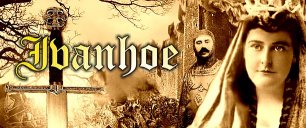 |
|
You are here:
Extract from the chapter about the Beecham Opera Company's The programme was made up of Electra, A Village Romeo and Juliet, Ivanhoe, Tristan und Isolde, The Wreckers, Carmen, Hänsel und Gretel, and L'Enfant Prodigue. Just as A Village Romeo and Juliet and The Wreckers represented the living English School, so the revival of Ivanhoe was an act of respect to a dead English master, Sullivan. It was essentially an affair of action and spectacle, and the designers and machinists saw their opportunity and went out boldly to grasp it. I was guaranteed effects of wonder and excitement that would outmatch the most thrilling Drury Lane melodrama, and tons of timber were ordered for the scenes of the tournament and the burning of the Castle of Torquilstone. In those days we had not yet escaped from the cycle of ultra-realism in stage decoration and everything had to be as life-like as possible. If there was a house on the stage it must be a real house; trees and waterfalls must be the things themselves; and artists as well as the public took a childish delight in going farther than merely holding the mirror up to nature. This phase came to an end shortly afterwards when a celebrated actor-manager, nervously uncertain of the effect likely to made on his cultivated audience by the unassisted recital of Shakespeare's verse, was moved to enliven the occasion by letting loose on stage a brood of tame rabbits during Oberon's magnificent speech in A Midsummer Night's Dream. Naturally against this rival attraction on the boards the unfortunate Bard had very little chance. I soon observed that the soaring ambitions of the scenic department were reacting none too favourably upon the musical side of the work. There were so many buildings, fences, trees, rivers and animals encumbering the stage that there was hardly any room upon it for the unlucky singers; and as for the chorus and supers numbering nearly three hundred, it was evident that if something were not done to accommodate them better they would have to sing in the adjoining market. But it is as difficult to alter traditional methods in a theatre as to impose economy on a Government department, and I waited and vacillated until the final rehearsal, when the grand surprises were to be seen in their full glory. The burning of the castle was certainly an astonishing triumph as viewed from the auditorium, but it was appreciated less by the occupants of the crowded stage. For regardless of the value of human life, huge chunks of masonry flew in every direction, spreading terror among the attackers and defenders alike. There was almost a riot, and undoubtedly there would have been no performance if I had not given my word to control the enthusiasm of the realists. All that day there was a depressed exodus from the theatre of about as much wood and other solid material as would have built a good sized sailing yacht. [Beecham, Thomas: A Mingled Chime, Hutchinson & Co., (n.d), p. 89.] Page created 3 October 2003 |